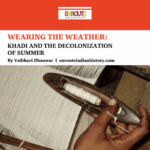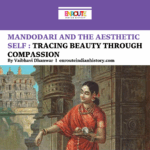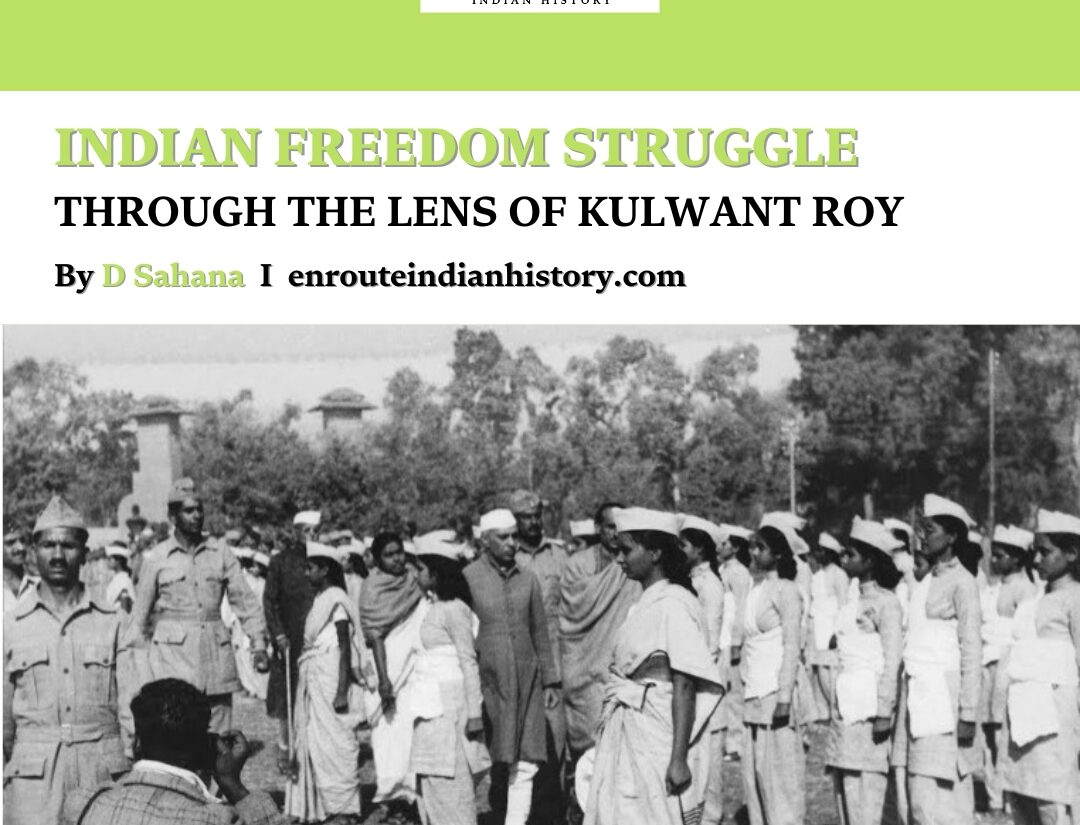
With the 78th Indian Independence Day this year, the history of Indian independence was a long struggle faced with many hardships. From its nascent stage of negotiations in the early parts of the 20th century to the mass demonstrations and public boycotts, every aspect of human life in the Indian subcontinent was subsumed with the idea of gaining freedom. This article aims to look at the works of the photojournalist Kulwant Roy and how his pioneering work in photography did not just catch glimpses of the people involved in the freedom movement but also showed us the making of a new, young, and free India.

Kulwant Roy with his Royal Indian Air Force Colleagues
(source: https://artsandculture.google.com/asset/kulwant-roy-with-his-royal-indian-airforce-colleagues/IAGvQBY0wzYlpQ?hl=en)
Born in 1914 at Bagli Kalan, Ludhiana, Punjab. Roy joined Gopal Kuteer’s studio in Lahore and began his photojournalism work in the 1930s. He captured photos of various Indian National Congress leaders actively involved in demonstrations, political speeches, and activities relating to the freedom movement. In 1941, he joined the Royal Indian Air Force and was stationed at Quetta(in Pakistan) to photograph aerial views of the North Western Frontier Province. After two years, however, he was removed from service as he protested against the discriminatory practices taken against Indians. Hence, he returned to Lahore to set up a photojournalism agency named Associated Press Photos. He soon shifted his base from Lahore to Mori Gate, Delhi. He actively participated in clicking various Indian independence movement images. He also photographed the construction of the Bhakra Nagal Dam, the Sino-Indian War of 1962, and the Indo-Pakistan War of 1965. He also documented important diplomatic visits of foreign dignitaries such as Jacqueline Kennedy in 1962. However, in the decades of 1970s and 1980s, there was a decline in work opportunities and his health; he passed away in 1984 after a long battle with cancer.
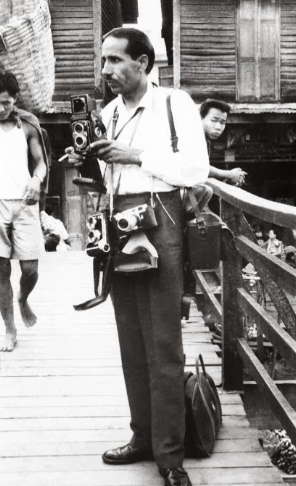
Kulwant Roy, Japan 1961
(source:https://artsandculture.google.com/asset/kulwant-roy-in-japan/5QFMe1BVkcGu5g?hl=en)
INDIAN TRANSFORMATION THROUGH KULWANT ROY’S CAMERA LENS
The decades between the 1930s and 1950s were a transformational age for India. The idea of a free India was brewing among the independence movement’s leaders and percolating to the general masses. These decades saw the mass appeal of the Indian National Congress and how the history of Indian independence became intertwined with the rise of the Indian National Congress. Many ideas were brewing on what this free India would look like. The major events which marked this period were the launch of the Civil Disobedience Movement in the 1930s, the Quit India movement in the early years of the 1940s, the subsequent exit of the British from India and the partition and the independence of the two nations: India and Pakistan in 1947.

Sardar Patel, Mahatma Gandhi and Sarat Chandra Bose (seated R to L) at the special session of the All India Congress Committee, 1946
(source: https://artsandculture.google.com/incognito/asset/sardar-patel-mahatma-gandhi-and-sarat-chandra-bose-seated-r-to-l-at-the-special-session-of-the-all-india-congress-committee/UgHR7y-RM1JQog)
RISE OF THE CAMERA AS A MEDIUM OF SHOWCASING ANTI-COLONIAL STRUGGLE
With these immense life-changing events occurring in the subcontinent, the camera gives us a better glimpse of the ground reality than texts. Sonal Vij, a Delhi-based photographer and visual anthropologist, writes that earlier photography was used by the British to portray grandeur and power; the circulation, however, remained limited. This makes us understand that, like the earlier authorities of power who used painting as a medium of influence and authority, photographs too began to be used as not just tools of power but also propaganda.
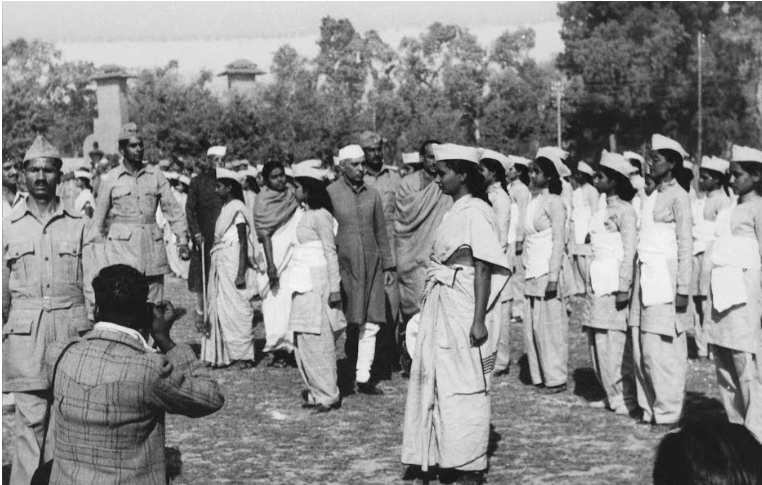
Meerut Congress Session, 1946
(source: https://artsandculture.google.com/incognito/asset/meerut-congress-session/IwEKnwvg2C_vVA)
However, by the 1920s and 30s, the camera gained popularity; it started being used to record anti-colonial sentiments and struggles. She further writes that during this time, many newspapers, both Indian and British, became avid consumers of photographs. Sonal Vij further writes that, due to high illiteracy in India, even if people could not read newspapers, they could undoubtedly identify with pictures. Pictures became one of the sole mediums through which people could view historical photos of Indian independence. It was the 1930s when there was a new range of cameras like Leica. The 35mm Leica was smaller, and it was a single-lens camera. Simultaneously, the invention of the flashbulb between 1927 and 1930 helped take photographs in low-light conditions much more accessible.
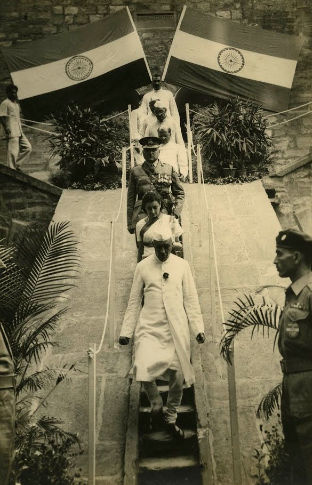
Prime Minister stepped down from the Red Fort ramparts after unfurling the national flag, followed by his speech on 15th August.
(source:https://artsandculture.google.com/incognito/asset/prime-minister-stepping-down-from-ramparts-of-the-red-fort-after-unfurling-the-nation-flag-followed-by-his-speech-on-15th-august/WAE6rXIm0EaJpg)
It is in this context that the works of a photojournalist come into the picture; photos are not always taken casually; photos reflect a particular time and context and bear a message underlying within those images. Hence, the works of photojournalists like Kulwant Roy captured images of the independence movement and the idea and the making of a nation. He captured the mass demonstrations and the people’s daily lives within the transformational space of a new India. Kulwant Roy’s photography captured the political metaphors and the shared optimism present in the various events during that time.
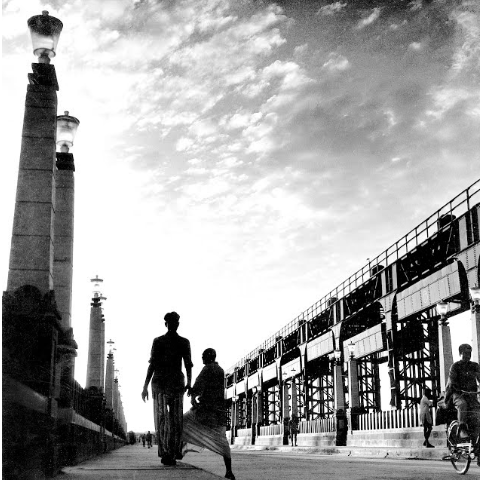
Bhakra Nangal Dam, 1950s
(Source: https://artsandculture.google.com/incognito/asset/bhakra-nangal-dam-1950s/dwGvokuQJU2WMQ)
KULWANT ROY’S LEGACY
Kulwant Roy’s legacy was obscured for nearly thirty years between his death and the recovery of his negatives. His legal heir, a collector and photographer, Aditya Arya, archived all of Roy’s surviving images and incorporated them into the India Photo Archive Foundation. With this, Kulwant Roy’s photographs have been published in books and exhibited in various photo exhibitions at the Indira Gandhi National Centre for the Arts, National Gallery of Modern Art in Delhi and Mumbai, etc.
REFERENCES:
Kulwant Roy – Google Arts & Culture. https://artsandculture.google.com/incognito/entity/kulwant-roy/m043rk0h?hl=e.
Kulwant Roy: a pioneer of Indian photojournalism – Google Arts & Culture. https://artsandculture.google.com/story/kulwant-roy-a-pioneer-of-indian-photojournalism-india-photo-archive-foundation/DwXxpdm9hVJHIQ?hl=en.
MAP Academy (2023) Kulwant Roy – MAP Academy. https://mapacademy.io/article/kulwant-roy/.
National Gallery of Modern Art, New Delhi. https://ngmaindia.gov.in/ngma_mumbai_vg-kulwant-roy.asp.
Rathi, N. (2017) ‘Rare photos of Jawaharlal Nehru from the archives of photojournalist Kulwant Roy,’ The Indian Express, 17 August. https://indianexpress.com/article/india/nehru-archival-images-through-the-lens-of-photojournalist-kulwant-roy-4797353/.
Vij, S. (2014) ‘THROUGH THE GAZING GLASS: A Gender Comparative Study of the Works of Homai Vyarawalla and Kulwant Roy,’ S.H. Research Journal: Humanities & Business Studies, X(1 & 2). https://d1wqtxts1xzle7.cloudfront.net/56586834/Through_The_Gazing_Glass_by_Sonal_Vij-libre.pdf?1526534955=&response-content-disposition=inline%3B+filename%3DThrough_The_Gazing_Glass_by_Sonal_Vij.pdf&Expires=1723368694&Signature=Yrxz2vIlDSA6ESgRs7Ixq-DG3kPZzzrSxgTfBXZnrIDOvYxyvPxN-Z4RrfOFAno4sAR3FrsPCFdzrymK0vwBJtDak6jVN2kgyP8W1mHRqOh1J-y~yag33xfC7QUsq44T-7tg~3ZBE3aH5aHqrM24ZDK0aUopVxkEk0vYtU-balY3ODQ8fdBHT8P5~aI-OIeh153T9NWOuhWRAYOWGdwdmV33hyt8xV4d-v5-1t~Okg-qerc4X-ZiUXK3bkZDpnoCHspScuYBygTWu5dejQP0PR2vrRJPh8XEaKRoKb7unvrDPp8SZDaGe4L6C8UKqc24zdiua8eFjdHEiCv2bUZarA__&Key-Pair-Id=APKAJLOHF5GGSLRBV4ZA.
- Freedom fighters photographs India
- Historical photos Indian independence
- History of Indian independence
- Indian freedom movement photography
- Indian freedom struggle photos
- Indian independence movement images
- Indian independence photojournalism
- Kulwant Roy freedom struggle
- Kulwant Roy photography
- Photography of Indian freedom struggle
